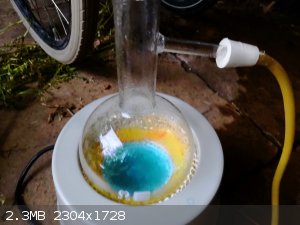ATPfactory
Harmless

Posts: 3
Registered: 21-6-2021
Location: definitely not Jupiter
Member Is Offline
|
|
What is this yellow stuff?
Yesterday I made some copper acetate with copper, vinegar and hydrogen peroxide. Today I wanted to evaporate the vinegar off so I'd get copper acetate
crystals. I had attached a rubber hose that I put in some water to get rid of the smell from the vinegar fumes. I think the yellow stuff came from
something that decomposed in the hose when the temperature got high enough. Since the hottest part of the hose lost its color. But I have no clue what
it is exactly. When I was cleaning the glassware, and filled it with water, the water became yellowish and pretty cloudy. Do any of you know or have a
good guess what it is?
edit: the hose is made out of latex

[Edited on 13-7-2021 by ATPfactory]
[Edited on 13-7-2021 by ATPfactory]
|
|
|
vmelkon
National Hazard
   
Posts: 669
Registered: 25-11-2011
Location: Canada
Member Is Offline
Mood: autoerotic asphyxiation
|
|
My guess it is some copper compound. Perhaps you heated your liquid to drying and the edges overheated.
Signature ==== Is this my youtube page? https://www.youtube.com/watch?v=tA5PYtul5aU
We must attach the electrodes of knowledge to the nipples of ignorance and give a few good jolts.
Yes my evolutionary friends. We are all homos here. |
|
|
Amos
International Hazard
    
Posts: 1406
Registered: 25-3-2014
Location: Yes
Member Is Offline
Mood: No
|
|
I've observed bright yellow-orange regions in solid copper(II) acetate before when it was boiled to dryness in a beaker and then heated for a little
while longer. I'm really not sure what it could be, but I'm tempted to say it is some kind of copper-containing substance and not from the latex.
Copper(I) oxide has a hydrated form which is that exact color, so it may be plausible that a little of your copper(II) was reduced back to copper(I)
by elemental copper after most of the acid had been consumed. If you managed to collect a little bit of the yellow precipitate, you should leave it
exposed to air and light and see if it turns brown and eventually black.
|
|
|
unionised
International Hazard
    
Posts: 5102
Registered: 1-11-2003
Location: UK
Member Is Offline
Mood: No Mood
|
|
Heating copper (II) acetate will give rise to "organic stuff" and that can reduce copper (II) to copper (I) .
|
|
|
Syn the Sizer
National Hazard
   
Posts: 591
Registered: 12-11-2019
Location: Canada
Member Is Offline
|
|
Food grade vinegar often contains a sugar impurity. Pickling vinegar is usually sugar free as is cleaning vinegar. Maybe it is a reaction between
sugar, H2O2 and copper. Just a thought.
|
|
|
ATPfactory
Harmless

Posts: 3
Registered: 21-6-2021
Location: definitely not Jupiter
Member Is Offline
|
|
Quote: Originally posted by Amos  | | I've observed bright yellow-orange regions in solid copper(II) acetate before when it was boiled to dryness in a beaker and then heated for a little
while longer. I'm really not sure what it could be, but I'm tempted to say it is some kind of copper-containing substance and not from the latex.
Copper(I) oxide has a hydrated form which is that exact color, so it may be plausible that a little of your copper(II) was reduced back to copper(I)
by elemental copper after most of the acid had been consumed. If you managed to collect a little bit of the yellow precipitate, you should leave it
exposed to air and light and see if it turns brown and eventually black. |
I didn't collect it, but I kept heating it until almost all of the liquid was evaporated. At that point the highest part of the yellow ring had turned
a bit brown with some black parts.
So you are probably right.
|
|
|
BackyardScience2000
Harmless

Posts: 5
Registered: 10-9-2019
Member Is Offline
|
|
Agreed with what's been said already. Probably reduced to copper (I) and if food grade vinegar was used then probably some contamination as well.
For future use, I would buy some lab grade glacial acetic acid and dilute to needed levels. Just a thought. 
|
|
|
Fantasma4500
International Hazard
    
Posts: 1677
Registered: 12-12-2012
Location: Dysrope (aka europe)
Member Is Offline
Mood: dangerously practical
|
|
you should try boiling a bit of the vinegar away and if it isnt brown at that point add some concentrated H2SO4, ive just boiled down a load of CuAc
and nothing came out brown, CuAc is rather black with a slight blue tint
|
|
|
Yttrium2
Perpetual Question Machine
    
Posts: 1104
Registered: 7-2-2015
Member Is Offline
|
|
Lapis Philosopherum
|
|
|